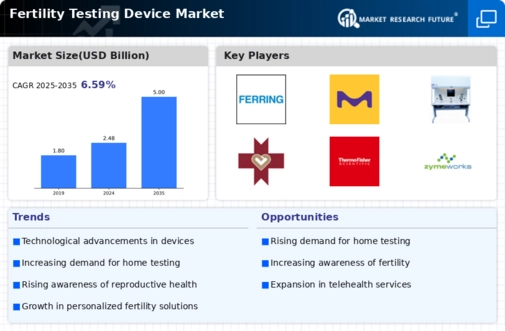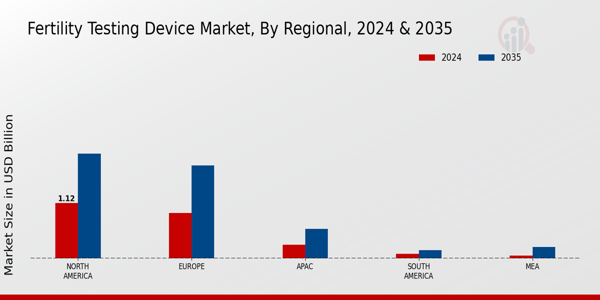Market Growth Projections
The Global Fertility Testing Device Market Industry is poised for substantial growth, with projections indicating a market value of 2.48 USD Billion in 2024 and a potential rise to 5 USD Billion by 2035. This growth trajectory suggests a compound annual growth rate of 6.58% from 2025 to 2035. Factors contributing to this expansion include increasing awareness of fertility issues, technological advancements, and a shift towards home-based testing solutions. As the market evolves, it is likely to attract new entrants and innovations, further enhancing the landscape of fertility testing devices.
Rising Awareness of Fertility Issues
The increasing awareness surrounding fertility issues is a prominent driver of the Global Fertility Testing Device Market Industry. As more individuals and couples recognize the importance of reproductive health, the demand for fertility testing devices has surged. Educational campaigns and healthcare initiatives have contributed to this awareness, leading to a greater understanding of fertility challenges. This trend is reflected in the market's projected growth, with an estimated value of 2.48 USD Billion in 2024. The focus on early detection and proactive management of fertility issues is likely to propel the market further, as individuals seek reliable solutions to assess their reproductive health.
Demographic Changes and Delayed Parenthood
Demographic changes, particularly the trend of delayed parenthood, are shaping the Global Fertility Testing Device Market Industry. As individuals and couples choose to prioritize education and career advancement, they are often postponing family planning. This shift has led to an increased demand for fertility testing devices, as many seek to understand their reproductive health later in life. The market is expected to respond to this demographic trend, with projections indicating a growth to 5 USD Billion by 2035. As awareness of age-related fertility issues rises, the need for effective testing solutions is likely to become even more pronounced.
Shift Towards Home-Based Testing Solutions
The shift towards home-based testing solutions is significantly influencing the Global Fertility Testing Device Market Industry. Consumers are increasingly favoring the convenience and privacy offered by at-home testing kits, which allow individuals to assess their fertility without the need for clinical visits. This trend is driven by a desire for autonomy in reproductive health management and the growing availability of reliable home testing options. As the market adapts to this consumer preference, it is likely to see substantial growth, contributing to the projected market value of 2.48 USD Billion in 2024. The rise of home-based solutions may redefine the landscape of fertility testing.
Increasing Investment in Reproductive Health
The Global Fertility Testing Device Market Industry is witnessing a surge in investment directed towards reproductive health. Governments and private organizations are recognizing the importance of fertility solutions and are allocating resources to support research and development in this field. This influx of funding is expected to enhance the availability and affordability of fertility testing devices, making them more accessible to a broader audience. As a result, the market is projected to grow at a compound annual growth rate of 6.58% from 2025 to 2035. This investment trend reflects a commitment to improving reproductive health outcomes and addressing the growing demand for fertility solutions.
Technological Advancements in Testing Devices
Technological advancements play a crucial role in shaping the Global Fertility Testing Device Market Industry. Innovations such as smartphone integration, enhanced accuracy, and user-friendly interfaces have made fertility testing more accessible and appealing to consumers. Devices that provide real-time data and personalized insights are gaining traction, as they empower users to make informed decisions about their reproductive health. The continuous evolution of these technologies is expected to drive market growth, with projections indicating a rise to 5 USD Billion by 2035. As consumers increasingly seek convenient and effective solutions, the market is likely to benefit from ongoing technological developments.




















